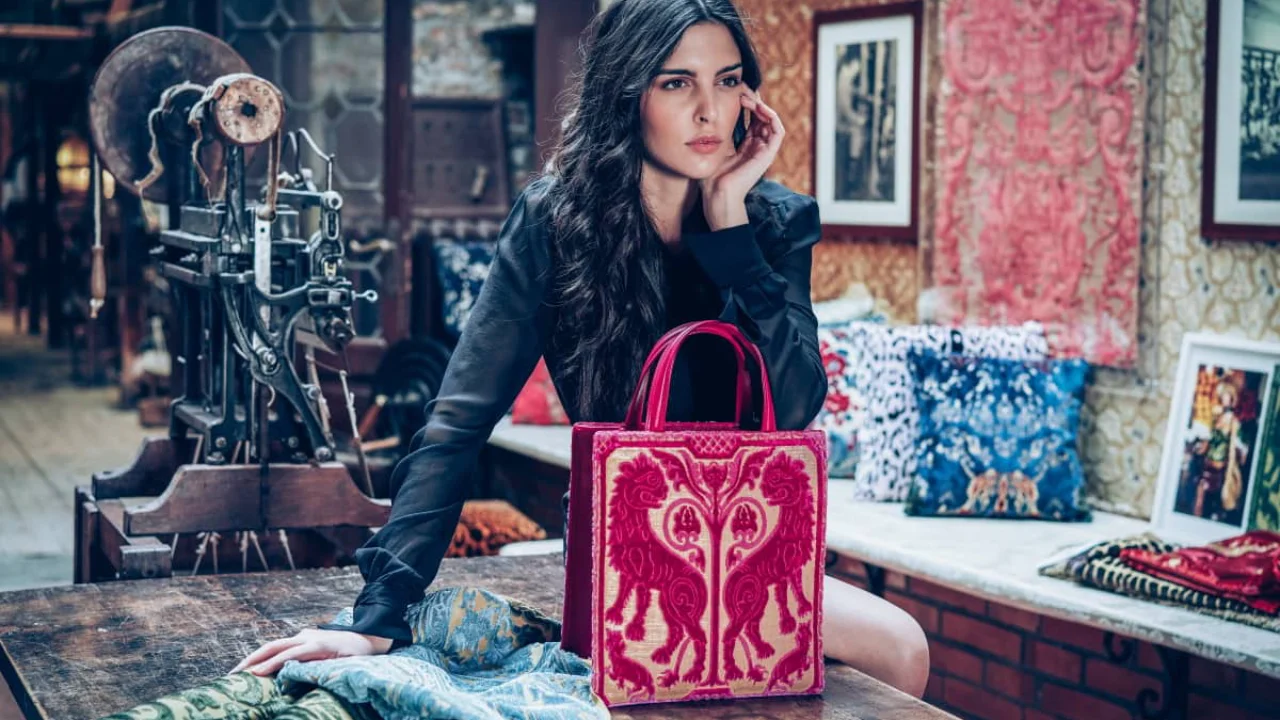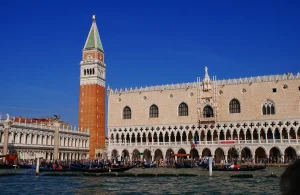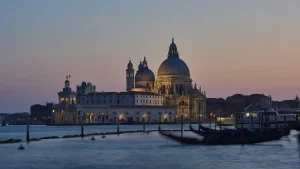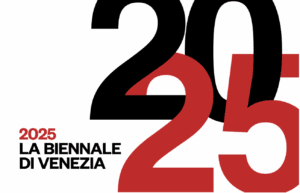Venice has many secrets, but few are as soft, luminous, and enduring as velvet. High above the Grand Canal, in a quiet workshop that hums with the rhythm of centuries, silk threads are still being woven by hand on 18th-century looms. This is Tessitura Luigi Bevilacqua — a living time capsule of artistry and devotion, where the past isn’t preserved behind glass, but woven anew every day.
Most travelers come to Venice for the light, the art, the gondolas. But those who join Tour Leader Venice for a private visit to Bevilacqua discover something rarer: the pulse of human craftsmanship that built this city, one thread at a time.
1️⃣ Where Silk Meets Silence
The first thing you notice when you step into the workshop isn’t color — it’s sound. A low, wooden creak. A whisper of silk sliding through fingers. A rhythm older than electricity. Sunlight spills through high windows, illuminating skeins of ruby, gold, and emerald. Dust motes drift like tiny constellations above the looms.
There are no machines here, no conveyor belts. Only patience — and people. The weavers sit tall on narrow benches, eyes fixed on the warp, hands moving in choreography learned over decades. They barely glance at what they’re doing; their bodies remember. Watching them is like watching music take form, each motion a note in a centuries-old symphony.
“Velvet,” one weaver says softly, “has its own soul. You can feel it breathe when it’s born.”
2️⃣ The Long Thread of History
Venice’s love affair with textiles began in the Middle Ages, when merchants brought silks and dyes from Byzantium and beyond. By the 15th century, the city’s velvet was more coveted than gold. Venetian fabrics lined the walls of the Doge’s Palace, clothed popes and princes, and adorned theatres from Paris to St. Petersburg. Owning Venetian velvet was the ultimate luxury — proof of taste, wealth, and status.
The Bevilacqua family’s connection to this art stretches back to those same centuries. But it was Luigi Bevilacqua who, in 1875, decided that the only way to protect Venice’s textile soul was to keep it alive — not as nostalgia, but as practice. He salvaged abandoned looms from the disused Scuola della Misericordia and brought them to a palazzo on the Grand Canal, where they still stand today. The creak you hear when you enter is the same sound that echoed through these halls more than two hundred years ago.
3️⃣ A Day in the Life of the Loom
Velvet weaving is one of the most intricate and demanding forms of craftsmanship on earth. Each loom at Bevilacqua is a labyrinth of pulleys, rods, and threads — thousands of them, stretched like a golden forest waiting to bloom. The weavers sit in near-silence, using small knives to lift and cut loops of silk that create the fabric’s plush surface. A single mistake can ruin days of work.
On average, an artisan might complete just ten centimeters of fabric per day. Ten. Each meter can take weeks — sometimes months. The result is so alive, so luminous, that you almost hesitate to touch it. These are not textiles meant to be consumed. They are meant to be cherished, passed down, remembered.
When you visit with Tour Leader Venice, the artisans welcome you into this hidden world. You’ll see the threads shimmer in the afternoon light, hear the quiet concentration of hands at work, and understand that here, time isn’t wasted — it’s woven.
Book Your Private Bevilacqua Experience
4️⃣ The Velvet That Conquered the World
Bevilacqua’s fabrics are everywhere once you start looking. They line the walls of royal palaces in London and the Vatican. They appear in the sets of La Traviata and Don Giovanni, in couture collections from Dior to Dolce & Gabbana, and in the private salons of collectors who whisper the name “Bevilacqua” like a secret.
Yet the studio itself feels almost monastic. Only about twenty weavers work here today, each dedicated to a specific loom, each responsible for patterns that can date back to the Renaissance. Some designs are drawn from paintings by Titian and Veronese. Others are contemporary reinterpretations — collaborations with modern designers who see in Bevilacqua’s looms not relics, but instruments.
“Our fabrics don’t just decorate rooms,” says one senior artisan. “They hold memory. Every thread has a story — of who made it, and for whom.”
5️⃣ The People Behind the Patterns
There’s something deeply human about these weavers. They don’t speak in terms of production or output. They talk about character, about how certain silks behave, how colors react to humidity, how every loom has its own temperament. One laughs, “This one is moody when it rains.” Another says she can hear when a thread goes wrong — not see, hear. It’s that kind of intimacy.
Several of Bevilacqua’s artisans come from families who’ve worked there for generations. They’ve seen apprentices become masters, daughters replace mothers, sons carve new patterns into old designs. Some recall weaving fabrics for the Vatican as young girls, others remember restoring antique patterns for European palaces. Each carries the quiet pride of someone who knows they belong to something bigger — a lineage, a language of hands.
6️⃣ A Hidden Treasure for the Curious Traveler
For visitors, discovering Bevilacqua is like stepping through a portal. One moment you’re on a bustling Venetian street, dodging selfie sticks; the next, you’re surrounded by the hum of looms and the scent of silk. It’s a kind of time travel — but also a lesson in presence. Here, there’s no rush, no algorithm, no clickbait. Only concentration and care.
Our Venice Hands-On Workshops follow this same philosophy: slow down, observe, and engage. We bring travelers into real studios, not showrooms — from glass bead workshops in Murano to mask-making experiences in Castello. But Bevilacqua is perhaps the most poetic stop of all. It’s Venice distilled — tradition, patience, and beauty, woven together in silence.
7️⃣ When Fashion Meets Faith
One of the most fascinating aspects of Bevilacqua’s history is its relationship with both sacred and secular power. The workshop has produced fabrics for popes and emperors alike. During your visit, you might see reproductions of 16th-century patterns originally made for the Vatican — crimson velvets embroidered with gold, destined for papal vestments and church draperies. In another corner, rolls of turquoise and silver brocade glisten under the light, created for a fashion house’s Paris runway.
This dual identity — between religion and fashion, past and future — is what keeps Bevilacqua relevant. It bridges worlds the same way Venice itself does, balancing reverence with reinvention. And that’s precisely why Tour Leader Venice loves bringing guests here: because it captures the soul of the city in one room.
8️⃣ Stories from the Looms
Every visit has its stories. One afternoon, an American guest — a designer from New York — watched an artisan cut the loops of a velvet pattern with a small knife. “I use Photoshop,” she whispered, “but this is the original design software.” Another time, a group of art students stood speechless as a weaver showed them how to read the punched cards that guide the looms. “It’s binary code,” one of them said. “Like an early computer.” The artisan smiled. “Yes,” she said, “only slower — and more beautiful.”
These encounters are what make our Bevilacqua experience so powerful. It’s not a performance. It’s a meeting of worlds — digital and tactile, modern and medieval, traveler and craftsman.
9️⃣ Venice as a City of Makers
Bevilacqua is just one thread in Venice’s wider tapestry of artisans. Across the lagoon, glassblowers at Murano workshops still shape molten sand into light. In Dorsoduro, printers like Gianni Basso keep letterpress alive. In Cannaregio, forcola carvers sculpt the oarlocks that power gondolas. These crafts are not hobbies — they’re heritage. And at Tour Leader Venice, we see it as our mission to connect travelers with them responsibly, respectfully, and meaningfully.
Every time a guest visits Bevilacqua, or creates their own glass bead, or learns to row a Venetian boat, they help sustain this fragile ecosystem. They become part of the story — proof that curiosity can preserve culture.
🔟 The Meaning of Luxury, Rewritten
True luxury, Bevilacqua reminds us, has nothing to do with price tags or perfection. It’s about rarity, time, and touch. It’s the knowledge that something was made — not produced. That it carries the breath of the person who made it. In an age of mass replication, that human fingerprint is priceless.
As one traveler told us after her visit: “I thought I was coming to see fabric. What I found was faith.”
🌍 Final Thought: The Hands That Hold Venice Together
Venice has survived empires, floods, and tourism — because it still believes in people like the weavers of Bevilacqua. In their patience, their pride, their ability to create beauty from chaos. Watching them at work is watching the city’s heartbeat. Every thread they weave is a promise: that craftsmanship still matters, that beauty still saves, that Venice will not fade quietly into history.
When you join our Bevilacqua tour, you’re not just visiting an artisan — you’re witnessing a miracle of continuity. And when you leave, you’ll carry more than memories. You’ll carry a piece of the city’s soul — woven gently, deliberately, into your own.
Join the Bevilacqua Artisan Experience with Tour Leader Venice
© Tour Leader Venice — Authentic Guided Experiences in Venice







